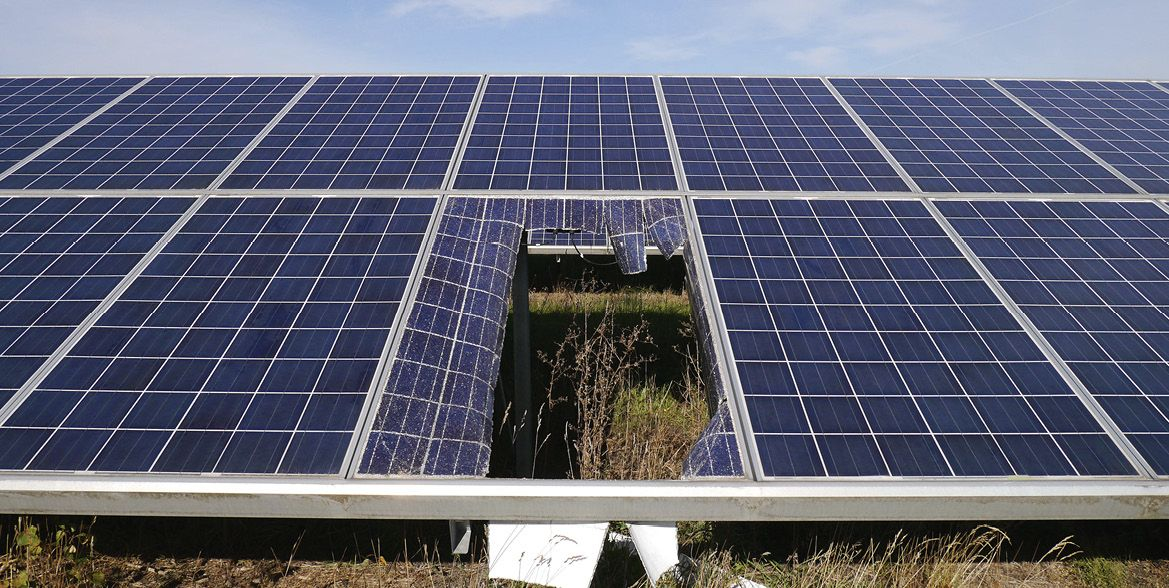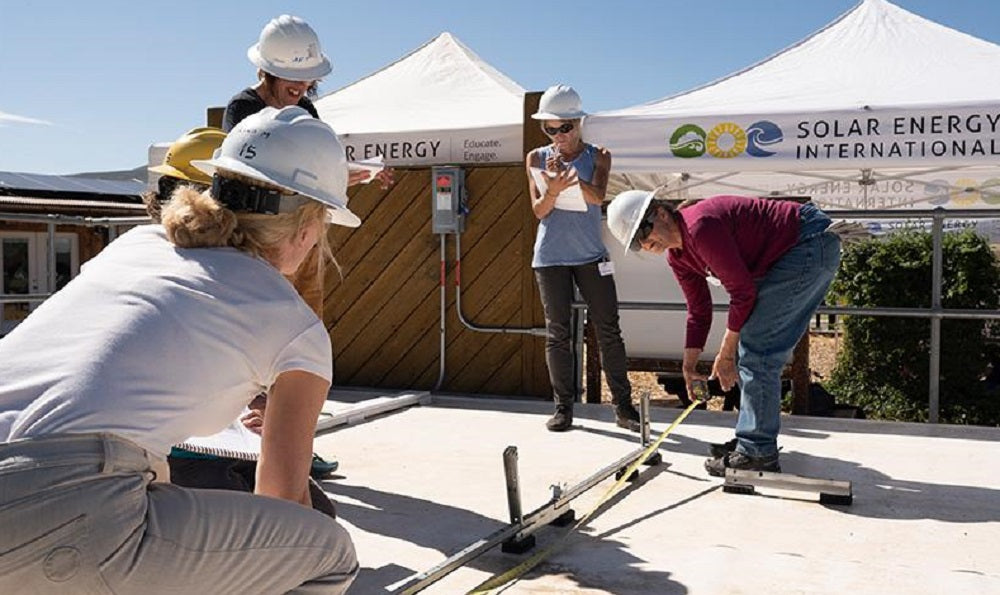https://www.pv-magazine.com/2023/09/09/weekend-read-a-10-gw-time-bomb/
A 10 GW time bomb

If the back foil tears, it is only a matter of time before the stability of a module fails completely.
Photo: Bernhard Weinreich, HaWe Engineering
Holger Schultheiß suspected what the installer inspecting his 11-year-old roof-mounted solar system last fall would find. Neighbors had experienced the same problems with inverter failure and strings staying offline.
The rear of the modules displayed checkerboard cracks, some visible from the front. Moisture in the panels caused leakage currents to flow between positive terminals and the ground. The inverter, which measures insulation, does not activate if insulation is too low. Around half the modules in Schultheiß’ 200 kW system were affected – in a year when installers had no time for repairs.
It has long been known some “AAA” backsheet films – made of triple-layer polyamide and widely deployed from 2010 to 2013 – can become brittle and tear. “By now, you would have to see the signs in all modules affected by this, whether they are installed in ground-mounted systems or on roofs,” says Bernhard Weinreich, managing director of HaWe Engineering. Now, younger modules and other foil types are exhibiting similar behavior.
Big problem
Some 15% of Germany’s solar capacity – 10 GW – could be affected. That equates to up to €2 billion ($2.18 billion) in replacement costs, with only a fraction of the affected panels likely detected thus far.
There are safety risks, too. Affected modules could electrocute if handled in wet weather and are more susceptible to fires. With some severely damaged panels showing only minor performance loss, how can damage be assessed? How long can such modules operate safely after initial premature aging signs?
Scientists have carried out extensive tests to assess the problem under the “Anomalous” project. The findings of bodies including HaWe, Forschungszentrum Jülich, ZSW Baden-Württemberg, and the Fraunhofer Center for Silicon Photovoltaics (CSP) were presented at the PV Symposium held in Bad Staffelstein in March.
HaWe’s Weinreich estimated the 10 GW figure, including 2 GW of severely-affected panels installed between 2010 and 2012; and 6 GW installed between 2004 and 2014, that feature other backsheet types and are expected to fail before their 20-year lifespan. “We had purchased our plant as a financial investment and retirement provision,” says Schultheiß. After 10 years, the array was just into profit and Schultheiß replaced around 300 affected modules with 150 new, higher-power ones.
Time has previously been on the side of manufacturers and PV system operators. The longer replacement could be postponed, the cheaper new panels became. High electricity prices helped ensure repowering remained viable. Panel prices rose last year, however.
Spotting faults
The Anomalous project findings will inform an equipment safety standard expected from German body VDE (the Verband der Elektrotechnik, Elektronik und Informationstechnik) by late September. The standard will help identify, classify, and evaluate module backsheet defects and track changes in them.
“The basis of the safety assessment is that photovoltaic modules are protection class 2 products,” says Bengt Jäckel of Fraunhofer CSP, one of the authors of the planned VDE spec. “This means that lay people without any special prior knowledge may touch them and that they must not pose any danger. If this is no longer guaranteed for a system, it must be transferred to a safe state.” The regulation will assess safety using a checklist.
“It starts with visual inspection and the question, is the observation relevant to electrical safety and is it a serial defect or an isolated case?” says Jäckel, referring to signs including chalking, discoloration, corrosion of electrical connectors, cracks, delamination, or burn marks.
Corrosion on electrical cell connectors would be deemed low risk, for example. Green coloration towards the frame on cross-connectors would be medium to high risk and require back foil to be inspected more closely, by a specialist using non-destructive spectroscopy on cut-out film in the field or by a testing-institute lab.
Raman analysis, Fourier transform infrared, and near infrared reflectance accessory spectroscopy require costly equipment, Weinreich says, with the latter able to identify substances on the basis of peaks in measurement curves and compare them with a materials database. The use of a variety of additives and embedding films for backsheets, however, prevents the VDE spec containing a “blacklist” of backsheet materials.
Inspection issues
Inspectors that see corrosion may recommend insulation tests and reinspection, usually a year later. “No obligations arise from the VDE spec that go beyond the general electrotechnical rules,” says Jäckel. “Once a year, an inspection of operational safety is due anyway.”
The regulation will help identify critical faults sooner, standardize inspection, and make test results reproducible. “Insulation tests in the field, in particular, are often difficult to reproduce as the measured value depends on the weather situation over the previous few days and the possibility of thorough wetting,” says Jäckel. “If cracks or other abnormalities occur on several modules, one should also examine several, for example by wetting an entire strand completely from the front and heavily from the back to increase fault detection and reproducibility.”
System design and weather conditions could still cause a high scatter range of results so provisions have been made to help transfer findings from a measurement series in lab conditions to the field. For example, colder water results in higher insulation resistance, so the VDE guide will include a calibration curve.
Popular content
Inspectors must determine how much moisture modules absorb by soaking panels. “We then see that the insulation resistance of older modules drops quickly, typically within the first 48 hours. Newer modules usually don’t show this behavior,” says Jäckel, who adds, the public VDE guide will be free.
Monitoring trends
Richard Rath, managing director of Encome Deutschland, notes additional problems. “When insulation faults occur in 10-year-old inverters, the cause can be anywhere from the transformer to the module,” he says. “At the same time as polyamide backsheets, cables that are not waterproof have often been installed.”
“We suspected the cables before the foils were determined to be the cause of the fault,” an employee of one German engineering, procurement, and construction (EPC) company told pv magazine, on condition of anonymity. Some modules had polyamide foils with tears in the middle. Others had an intermediate layer showing breakage, which is more problematic. Fine cracks were only visible in spaces between cells against the light. Moisture penetrated laterally and took days to dry.
The EPC our source works for monitors long-term trends, says the employee, adding, “In certain plants, the insulation values decrease from winter to winter. That is a clear warning sign.” Evaluation is only available from central inverters in older PV projects.
Encome’s Rath does not believe monitoring clearly detects panel rear-side problems. “If we see insulation faults, we send an employee out to find the cause. A surveyor recognizes module problems; a maintenance installer has a hard time recognizing incipient foil problems.”
For smaller arrays, generally on the rooftop, that are installed with string inverters, there is an additional risk in that high temperatures can result in accelerated degradation – even with little exposure to UV. “Unfortunately, statistically reliable test figures are lacking here,” says HaWe Engineering’s Weinreich. “In some circumstances, only a few years remain for the renovation of affected areas until operations come to a standstill.”
Addressing insulation faults by shutting down individual modules is not enough, he warns. Claims should be reported immediately to manufacturers and other parties, including insurers.
Empty warranties
pv magazine‘s EPC source says warranties only apply if manufacturers are still keen to sell in Germany. Repairs were suggested to the source's company at one solar site, they add, “but that seemed futile to us and to the expert we commissioned.”
Replacement is a better option, even if it involves a rebuild to ensure old and new modules are not mixed on a string. While longer-term performance warranties should apply to safety-related shutdowns – rather than product guarantees – litigation is costly.
Schultheiß didn’t want the grief. “We would have had to test the modules and send in the test results in order to then possibly receive a time and value replacement,” he says. “The effort and benefit seemed disproportionate.”
Andreas Kleefisch, a lawyer at Baumeister Rechtsanwälte, knows the methods manufacturers can use to evade warranty commitments. “With certain manufacturers, not a single successfully settled warranty case has come to light,” he says. “With those, the warranty terms are designed in such a way that it’s virtually impossible for an operator to make a claim.” With others, he says, it’s a lengthy and arduous process.
Pleading a serial defect is the best approach, Kleefisch says, adding, “Then you can raise that for all the affected modules and don’t have to wait for it to develop in detail.” Encome’s Rath also cites cases where operators were only able to negotiate discounted new purchases, under secret agreements.
Glass-glass options
Schultheiß opted for glass-glass replacement modules and the employer of our EPC source only buys glass-glass nowadays. Eric Lohse, team leader for quality management at German developer Enerparc says, “It has to be our goal that we don’t have any premature failures within the more-than-20-year lifetime. If we can achieve that with higher-quality, proven components, that have lower degradation, an increased initial investment pays off over the longer operating life.”
Unlike back-foil modules, he adds, “With glass-glass modules, you can always tell immediately if there’s damage in transit. It’s either intact or cracked.” HaWe Engineering’s Weinreich says glass-glass modules still experience problems in edge seals and Jäckel points out, “Glass manufacturers are also experimenting, whether with thinner glass, structured backs, or masked cell gaps. The trend toward thinner and thinner glass could significantly reduce the resilience to hail damage on the front side.”
Modules with backsheets are now tested more rigorously, including for UV radiation under weathering and interactions with embedding film. Either way, investors should be certain of module material composition, which is often available for a fee and can avoid field spectroscopy costs later on. Buyers should negotiate serial defect procedures with manufacturers and insist on a simplified proof procedure or reversed burden of proof as well as extended compensation for module replacement.
This content is protected by copyright and may not be reused. If you want to cooperate with us and would like to reuse some of our content, please contact: editors@pv-magazine.com.



